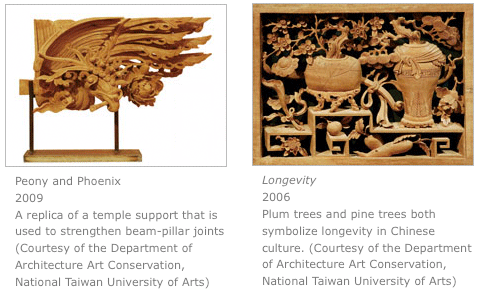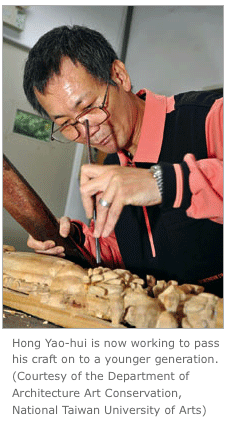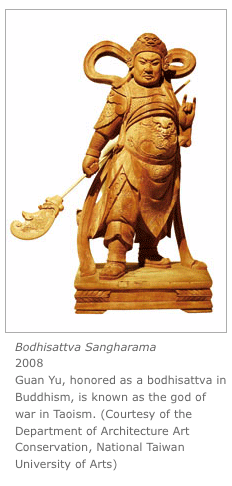Master temple woodcarver Hong Yao-hui’s latest project is to pass his craft on to a younger generation.

After working in temple woodcarving for 35 years, Hong Yao-hui held his first exhibition at the Taipei Cultural Center in November 2009. The 33 showcased carvings, including 12 borrowed from collectors, featured figures seen in traditional Chinese temples like dragons, Chinese unicorns, flying phoenixes, flowers and birds, as well as additional legendary or mythical characters.
These are just a small part of Hong’s works. Those who are interested in seeing the rest need to visit the Sanxia Zushi Temple, Chaiyi Chenghuang Temple, or one of the many other temples Hong has worked on.
Hong is now an assistant professor at National Taiwan University of Arts’ (NTUA) Department of Architecture Art Conservation, which is Taiwan’s first and only university department focusing on the restoration of historic buildings. Although he is now one of the few existing temple craftsmen in Taiwan, a career in woodcarving was not what Hong wanted initially.
Born to a salt-mining family in Beimen Township, Tainan County in 1959, it was clear to Hong that he had to start working to help support the family after completing his compulsory junior high school education. His first choice was to become a car mechanic or take up a similar trade, as he was interested in machines.
However, temple woodcarving seemed to be a more promising line of work as there were quite a few new temples being built around his coastal hometown. At his father’s insistence, Hong became an apprentice of Su Hai-ping, a master craftsman in the trade from Quanzhou, Fujian province, who lived in Tainan.
A typical workday for an apprentice started at five in the morning and ended—if he was lucky—at midnight. The jobs included cleaning, preparing meals and all kinds of errands. There was not too much time between chores for Hong to actually hold a knife and carve something.
The pay was far from handsome: NT$100 (US$2.50 at the exchange rate of the time) a month for the first six months, which gradually increased to NT$2,000 (US$50) after 30 months. Long hours of hard work with low pay was not exactly his idea of a good job, so Hong fled back home after a month with the master.
“The minute my father saw me at home, he beat me and sent me right back to the miserable life of an apprentice,” Hong recalls. “I guess I owe him a lot for helping me become what I am today.”
From Site to Site
Like all other craftsmen in temple work, woodcarvers were nomads moving from one project to the next. As an apprentice, Hong followed his master to sites around the island.
The construction of Puji Temple on Huayin Street in Taipei City was a project that Hong still remembers clearly, since he had to sleep under the open sky on cold winter nights when building the top floor of the temple and was often awoken by rain.
 When working on a project, the main carvings were done by the master craftsmen and the apprentices could only do small jobs like the final touchup and fine sanding of a piece.
When working on a project, the main carvings were done by the master craftsmen and the apprentices could only do small jobs like the final touchup and fine sanding of a piece.
“There were a lot of temples to build and the master craftsmen were commissioned project after project, so they had neither time nor energy to worry about passing down their crafts,” Hong says. “We learned by watching and practiced on our own.”
Usually, a traditional master-apprentice relationship that lasts for 40 months would only allow an apprentice to pick up the basic techniques.
Craftsmanship aside, the themes and subject matters of the carvings were also important parts of the trade. Liu Shu-yin, an assistant professor at NTUA’s Department of Architecture Art Conservation, notes that the objects or animals featured in these temple woodworks have specific meanings and are used to symbolize good fortune or blessings.
The Chinese word for deer, for example, is a homonym for the Chinese word for a high government post, while the word for bamboo is pronounced the same as the word for gain in Taiwanese. Putting the two in a work, therefore, symbolizes gaining a high government post.
Meanwhile, in Chinese the pronunciation for deer is also the same as that of road. A ruyi—an S-shaped ornamental object symbolizing good luck—in a deer’s mouth therefore symbolizes that every route leads to good fortune.
Specialists are used to design such combinations and draft the blueprints for a work, but the problem for craftsmen is that these specialists are becoming rare and are expensive.
To reduce “production costs” and skip the waiting periods for such designs, many craftsmen began keeping and studying copies of old designs they had carved in order to come up with new ones, a method that also ensured that they stayed within the old concept.
“Master craftsmen had no idea about the meanings or symbols of the images and the designers just threw you the draft and collected their pay,” Hong says. “We had to figure it out ourselves, or ask around if there were people who were willing to share.”
To learn more, many apprentices would still work for their masters after the standard 40 months of training. Hong worked as an apprentice until 1980.
Although he did not consider himself a sophisticated craftsman, Hong decided to start his own business when he got married, as he found that his apprentice’s income was insufficient to support a family.
Over the following five years, he worked as a master carver and participated in several temple projects. The focus was still temple work, but he was also carving traditional temple items such as windows or reliefs as home decorations for collectors.
Another part of his income came from the huge demand for statues of gods, as they were believed to bring good fortune in the illegal lotteries that were popular at the time.
Craft in Decline
 Meanwhile, the overall traditional woodcarving industry was fast declining as many temples gave their business to workers in mainland China. Hong explains that traditional craftsmen like him complete a piece by themselves, while craftsmen across the strait have turned carving into a production line process, where each worker is responsible for a small part of the final item and all the parts are shipped to Taiwan and then assembled and painted.
Meanwhile, the overall traditional woodcarving industry was fast declining as many temples gave their business to workers in mainland China. Hong explains that traditional craftsmen like him complete a piece by themselves, while craftsmen across the strait have turned carving into a production line process, where each worker is responsible for a small part of the final item and all the parts are shipped to Taiwan and then assembled and painted.
Adding the cost of all the raw materials, labor and shipping together, the mainland Chinese “products” are still cheaper than the raw materials alone in Taiwan.
“We locals are more than competitive in craftsmanship, but we’re out of the game pricewise,” he says. “Price, however, is the main consideration for many people.”
Fortunately, the entire market was not taken over by mainland China. Master painter Li Mei-shu (1902–1983), who in 1947 took charge of the third restoration project of Sanxia Zushi Temple, which was originally built in 1769, insisted on doing it the traditional way by employing traditional craftsmen.
The policy continued even after Li passed away and in 1986, Hong’s master Su Hai-ping was contracted for part of Zushi Temple’s carvings. Su asked Hong to be among his team members.
Hong took up the offer as he believed that the steady income from this long-term project would provide financial security as well as individual advancement, given that the work brought together the best craftsmen, historians and researchers in Taiwan.
Hong worked as part of the project for 15 years until 2001, when the temple management committee changed its policy from contracting individual craftsmen to working with bidding contractors.
Still, the artisan says the greatest reward he gained from the work was that he had the chance to learn from renowned “national treasure” craftsmen such as Huang Guei-li (1902–1995), as well as gain knowledge of temple decoration designs from consulting scholars and researchers involved in the restoration.
The Zushi Temple project was also a turning point for Hong’s career. In 2003, Wang Ching-tai, a professor at NTUA and one of the consultants Hong had become acquainted with during the project, asked Hong to teach in the Department of Architecture Art Conservation.
Hong recalls that Wang told him that traditional crafts were disappearing and his department wanted to do something about the discouraging trend before it was too late.
“As a craftsman, I’d not given much thought to cultural heritage,” Hong says. “But seeing the fast-decreasing number of craftsmen and lack of young blood in the trade, he was absolutely right about the disappearance of the craft.”
After some consideration, Hong agreed to teach, but moving from temples to a university classroom was not an easy task. Hong explains that traditionally, apprentices learned by observing their master.
“There wasn’t any ‘class’ on how to carve or references on what to carve,” Hong says. “How much an apprentice could pick up depended mostly on himself.” That approach apparently does not work in today’s higher education system.
It took Hong a while to be able to “translate” his craft into words and texts for the class. And unlike the traditional masters, who always kept a trick or two to themselves to avoid “competition,” Hong is eager to teach everything he knows.
Equally Challenging
Interestingly, Hong finds that 80 percent of his students are female, while women were traditionally barred from taking part in any temple project due to various taboos.
Male or female, the coursework is equally challenging for the students, who might be passionate about the preservation and restoration of historic relics, but have never held a carving knife.
Hong often stays late to help his students, hoping that they can at least pick up the basic techniques during their university studies and go from there.
For his achievement in traditional temple woodcarving and contribution to preserving the craft, Hong was awarded the First Taipei Master of Traditional Arts in 2009 at an event organized jointly by the city and county governments.
As a craftsman, Hong feels honored to have received the award, but as a preservationist, he thinks that the government’s effort is too little, too late when it comes to traditional crafts.
Higher education institutions, for example, seem to save their resources for science students, while some of his pupils, by comparison, have to worry about whether or not they can afford a piece of camphor wood for the class.
After devoting 35 years to temple woodcarving, Hong is probably entitled to grouse a little. But come another school day, he grabs his carving knives and heads to the school.
“I’ve worked project after project over the years and always get the job done,” he says. “The project I’m on now is to pass down the craft, and I’m also going to get that done.”
Source : http://taiwanreview.nat.gov.tw




